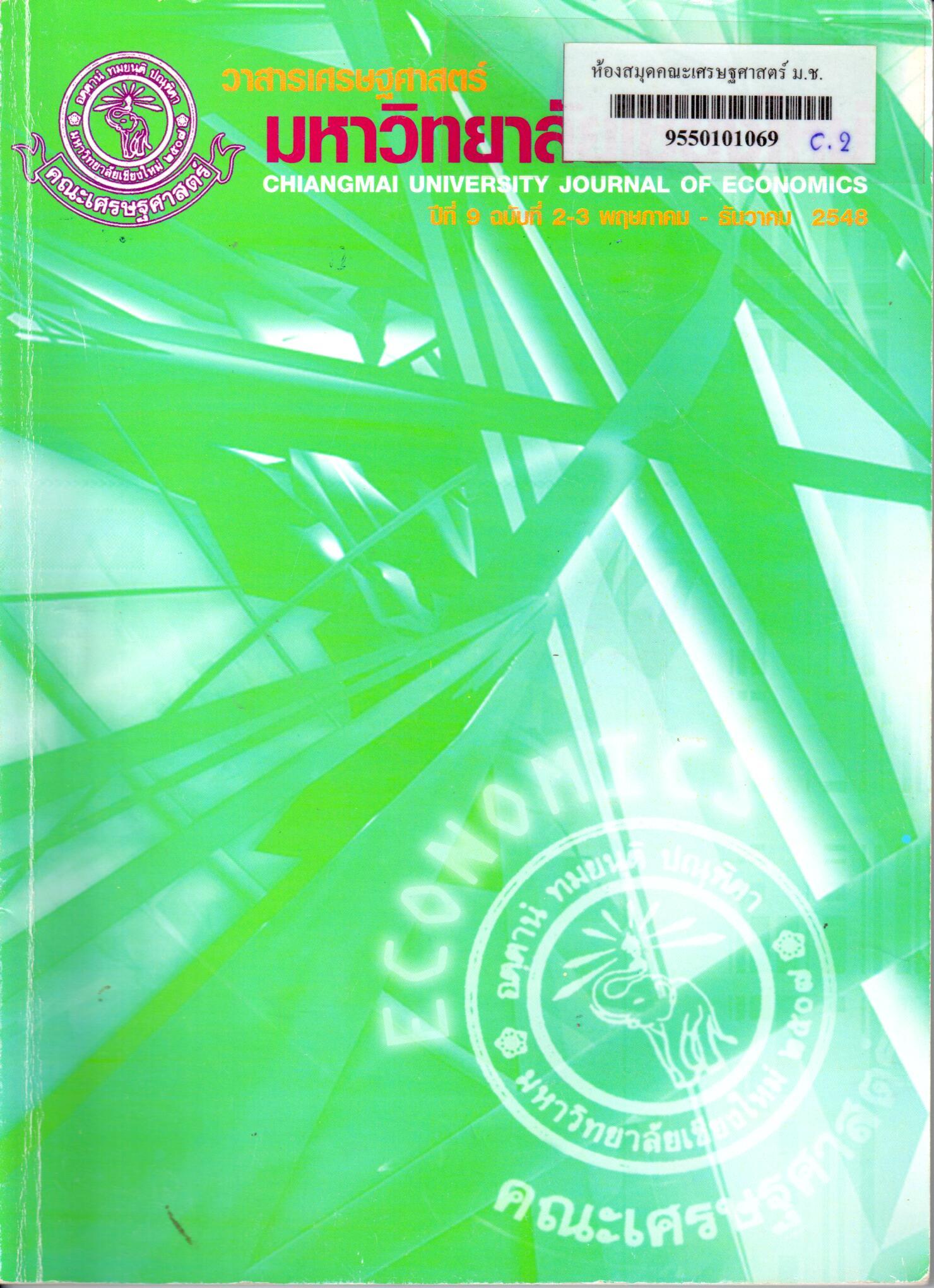การทดสอบแบบจำลองการตั้งราคาสินทรัพย์ประเภททุนสำหรับดัชนีบางหมวดในตลาดหลักทรัพย์แห่งประเทศไทย
Abstract
บทคัดย่อ
การศึกษานี้แบบจำลองการตั้งราคาสินทรัพย์ประเภททุนถูกประยุกต์ใช้สำหรับดัชนีราคารายหมวด 5 หมวดในตลาดหลักทรัพย์แห่งประเทศไทยเพื่อทดสอบความสามารถในการพยากรณ์ของแบบจำลองดังกล่าว ผลการศึกษาพบว่า conditional convariances ของดัชนีรายหมวดส่วนใหญ่มีค่าคงที่ อย่างไรก็ตามเมื่อทำการพิจารณาจากค่า R2 ซึ่งมีค่าสูงแสดงให้เห็นว่าการประมาณยังคงสามารถทำนายได้การทดสอบเกี่ยวกับ reward-to-risk ratio พบว่าค่าดังกล่าวมีค่าเปลี่ยนแปลงตามเวลาในการทดสอบสำหรับแต่ละดัชนี และพบว่าค่าดังกล่าวมีค่าที่แตกต่างกันสำหรับแต่ละดัชนี นอกจากนั้นจากการทดสอบพบว่าแบบจำลองควรมีค่าคงที่ (intercept term ) ในแบบสำรองซึ่งขัดแย้งกับเงื่อนไขของแบบจำลองดั้งเดิม การทดสอบที่สำคัญอีกอย่างหนึ่งคือการทดสอบแบบจำลอง CAPM โดยการยอมให้ excepted return, variances and convariances มีการเปลี่ยนแปลงตามเวลา ซึ่งพบว่าข้อจำกัดของแบบจำลองถูกปฏิเสธสำหรับการทดสอบในแต่ละดัชนี การทดสอบสุดท้ายคือการทดสอบความคงที่ของค่า พบว่าค่าดังกล่าวมีค่าคงที่ตามเงื่อนไขของแบบจำลอง ทั้งในกรณี single portfolio และ multiple portfolio
จากผลการศึกษาพบว่าเงื่อนไขบางประการที่ถูกกำหนดจากแบบจำลองไม่เหมาะสม ดังนั้นการใช้แบบจำลอง CAPM ในการอธิบายผลตอบแทนของดัชนีราคารายหมวดทั้ง 5 หมวดยังไม่เหมาะสมด้วยเช่นกัน
Abstract
In this study, Capital Asset Pricing Model (CAPM) was applied to five selected sectoral indices in the Stock Exchange of Thailand (SET) to test the predictive power of the model. Consequently, the conditional covariances of most sectoral indices were found to be constant. However, the high value of R2 in each case suggested the estimates could be quite accurate. The study on reward-to-risk ratio revealed that the ratio would vary through time for each sectoral index, and the ratio differed among various indices. The investigation also indicated that CAPM application should have constant intercept term which was contrary to the condition in the traditional models. Another important test of CAPM was on the provision for expected returns, variances, and covariances to vary through time. The result exhibited that this assumption could not be accepted in all cases of sectoral indices. The final test was on the nature of which was found to be constant according to the provision of the model for both single portfolio and multiple portfolio case.
The overall results suggested certain conditions defined by CAPM were not appropriate. In additional, the application of CAPM were not appropriate and the application of CAPM to explain the rates of return to assets in the selected sectors would not be appropriate accordingly.
Downloads
Issue
Section
License
All opinions and contents in the CMJE are the responsibility of the author(s). Chiang Mai University Journal of Economics reserves the copyright for all published materials. Papers may not be reproduced in any form without the written permission from Chiang Mai University Journal of Economics.
ข้อคิดเห็นที่ปรากฏและแสดงในเนื้อหาบทความต่างๆในวารสารเศรษฐศาสตร์มหาวิทยาลัยเชียงใหม่ ถือเป็นความเห็นและความรับผิดชอบโดยตรงของผู้เขียนบทความนั้นๆ มิใช่เป็นความเห็นและความรับผิดชอบใดๆของวารสารเศรษฐศาสตร์ มหาวิทยาลัยเชียงใหม่
บทความ เนื้อหา และข้อมูล ฯลฯ ในวารสารเศรษฐศาสตร์มหาวิทยาลัยเชียงใหม่ ถือเป็นลิขสิทธิ์เฉพาะของคณะเศรษฐศาสตร์มหาวิทยาลัยเชียงใหม่ หากบุคคลหรือหน่วยงานใดต้องการนำทั้งหมดหรือส่วนหนึ่งส่วนใดไปเผยแพร่ต่อหรือเพื่อกระทำการใดๆ จะต้องได้รับอนุญาตเป็นลายลักษณ์อักษร จากวารสารเศรษฐศาสตร์ มหาวิทยาลัยเชียงใหม่






